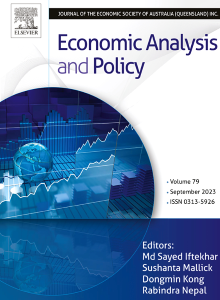Revisiting the impact of financial shocks on the fiscal position of euro area countries
IF 7.9
2区 经济学
Q1 ECONOMICS
引用次数: 0
Abstract
This paper investigates the impact of financial distress on fiscal dynamics in the euro area. Within our analysis, special attention is given to the period during the Great Recession. This period can be characterised by significant stock market declines, increased systemic risks, and bank failures, which compelled governments to take decisive actions to stabilise the economy and prevent the collapse of the financial sector. Unlike previous crises, these actions went beyond relying on automatic stabilisers, necessitating significant discretionary and interventionist government measures. Using a sample of 20 euro area countries from 1995Q1 to 2019Q4, we employ a structural panel VAR approach to capture cross-country heterogeneity and distinct effects of common and idiosyncratic shocks. To the best of our knowledge, this is the first study to analyse the highly complex transmission of financial shocks using such a methodology. The results demonstrate diverse responses in government debt-to-GDP ratios and bond yields across countries, with significant contributions from idiosyncratic shocks. Factors such as country size, trade openness, GDP per capita, financial sector size, and debt-to-GDP levels in the pre-crisis era influence the heterogeneity of these responses. Our results indicate that structural reforms and strict fiscal discipline during economic expansions are essential for rapid recovery after financial shocks. Sustainable fiscal policy and mutual debt issuance can reduce cross-country disparities and idiosyncratic effects, stabilising fiscal dynamics in the euro area.
重新审视金融冲击对欧元区国家财政状况的影响
本文研究了金融危机对欧元区财政动态的影响。在我们的分析中,我们特别关注大萧条时期。这一时期的特点可能是股市大幅下跌,系统性风险增加,银行倒闭,这迫使政府采取果断行动来稳定经济,防止金融业崩溃。与以往的危机不同,这些行动超出了依赖自动稳定器的范畴,需要政府采取重大的自由裁量和干预措施。使用1995年第一季度至2019年第四季度20个欧元区国家的样本,我们采用结构面板VAR方法来捕捉跨国异质性以及常见和特殊冲击的独特影响。据我们所知,这是第一项使用这种方法分析金融冲击高度复杂传导的研究。结果表明,各国政府债务与gdp之比和债券收益率的反应各不相同,特殊冲击的影响很大。危机前的国家规模、贸易开放程度、人均国内生产总值、金融部门规模和债务与国内生产总值之比等因素影响了这些应对措施的异质性。我们的研究结果表明,经济扩张期间的结构性改革和严格的财政纪律对于金融冲击后的快速复苏至关重要。可持续的财政政策和共同债务发行可以减少国家间的差异和特殊效应,稳定欧元区的财政动态。
本文章由计算机程序翻译,如有差异,请以英文原文为准。
求助全文
约1分钟内获得全文
求助全文
来源期刊

Economic Analysis and Policy
ECONOMICS-
CiteScore
9.80
自引率
9.20%
发文量
231
审稿时长
93 days
期刊介绍:
Economic Analysis and Policy (established 1970) publishes articles from all branches of economics with a particular focus on research, theoretical and applied, which has strong policy relevance. The journal also publishes survey articles and empirical replications on key policy issues. Authors are expected to highlight the main insights in a non-technical introduction and in the conclusion.
 求助内容:
求助内容: 应助结果提醒方式:
应助结果提醒方式:


